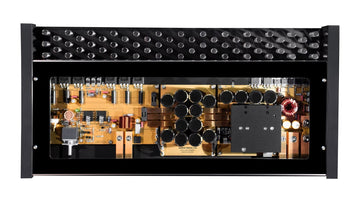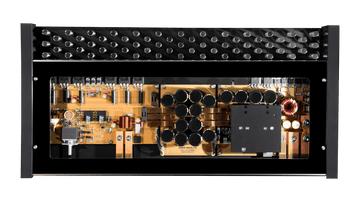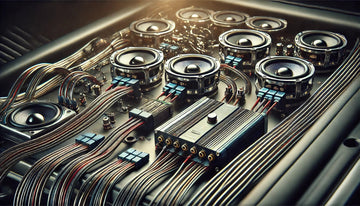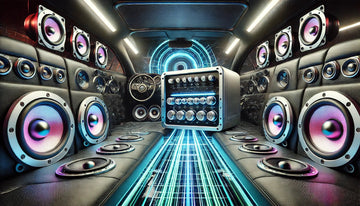A Class A amplifier is known for its high sound fidelity and low distortion. It keeps output transistors fully on, ensuring precise audio reproduction. This article explores why audiophiles prefer Class A amplifiers and what makes them unique in the world of high-fidelity audio.
Key Takeaways
-
Class A amplifiers are known for their high fidelity, offering low distortion and superior linearity, making them ideal for high-quality audio applications.
-
Despite their excellent sound reproduction capabilities, Class A amplifiers have disadvantages such as low efficiency and significant heat generation, requiring careful power supply and thermal management.
-
Class A amplifiers contrast with other amplifier classes like Class B, Class AB, and Class D, where they excel in sound quality but fall short in efficiency.
Understanding Class A Amplifiers
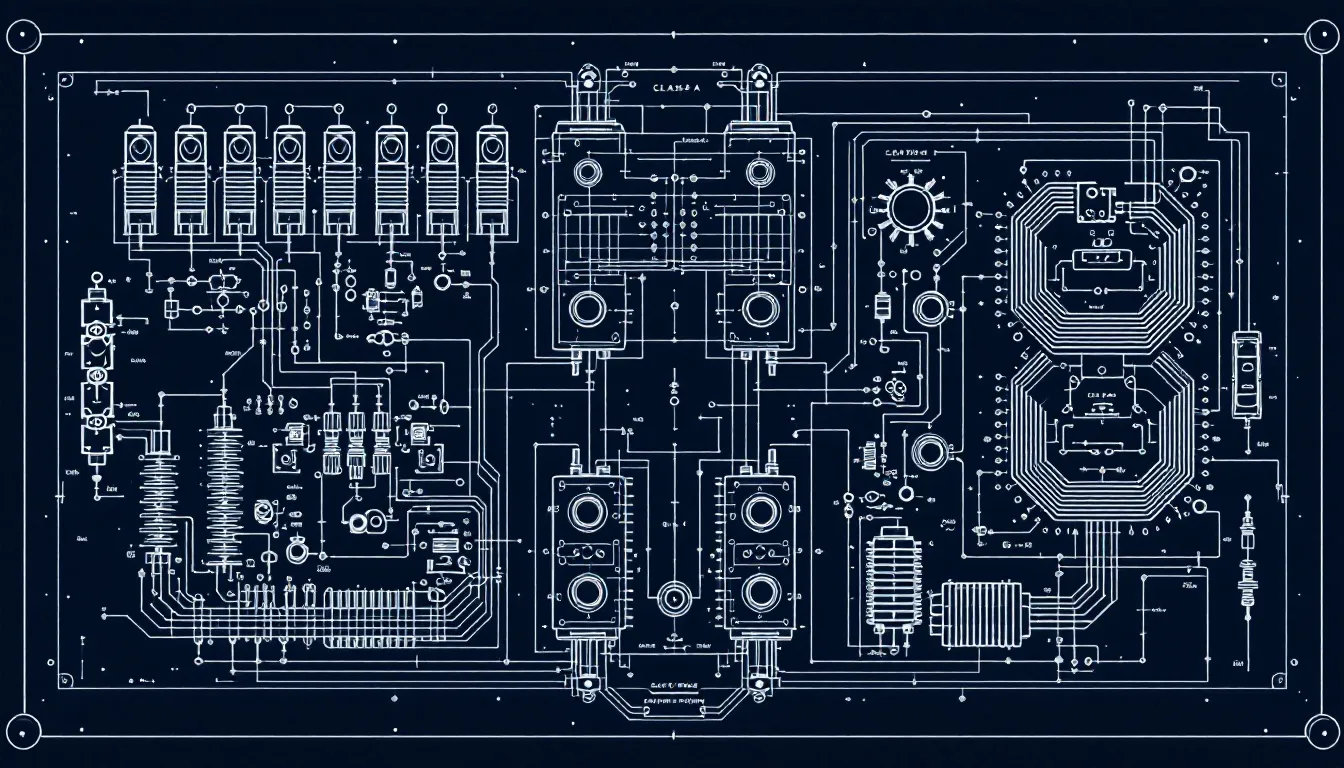
Class A amplifiers are in a league of their own, classified by setting the Q-point at halfway on the load line of the amplifier’s characteristics curve. This configuration ensures that the output stage is biased ON all the time, which means the output transistor is always conducting. The continuous operation of the transistor keeps it in its active region throughout the entire input signal cycle, ensuring high linearity and minimal distortion.
Despite their low efficiency, Class A amplifiers are renowned for their high fidelity. This makes them a popular choice among audiophiles and high-fidelity audio enthusiasts who prioritize sound quality over efficiency. Additionally, such amplifiers, along with audio amplifiers, class c amplifiers, and class e amplifiers, are also gaining attention for their unique characteristics.
The ability to faithfully reproduce audio signals without introducing significant coloration is what sets these amplifiers apart. Whether you’re an avid music lover or a professional in the audio industry, understanding the unique characteristics of Class A amplifiers will help you appreciate why they are often deemed the best for premium sound quality.
How Class A Amplifiers Work
The magic behind Class A amplifiers lies in their operational mechanics. These amplifiers operate by continuously conducting, allowing them to provide a stable output throughout the entire input cycle. This continuous conduction ensures that the signal remains linear and minimizes distortion across the audio spectrum. The design maintains a linear relationship between input and output, which is crucial for preserving audio fidelity.
High gain and consistent sound output are hallmarks of Class A amplifiers, thanks to their ability to operate in the linear region continuously. By avoiding the cut-off and saturation regions, these amplifiers achieve a level of performance that is highly sought after in the world of high-fidelity audio.
To fully grasp how these amplifiers work, we need to delve into two critical aspects: single output transistor conduction, voltage amplifier functionality, and power supply requirements.
Single Output Transistor Conduction
Class A amplifiers utilize a single output transistor that remains in a conducting state throughout the entire input signal cycle. This design allows the single output transistor to handle the entirety of the input signal cycle. The transistor is never driven into cut-off or saturation regions, ensuring it conducts current throughout the entire input cycle. This continuous conduction is what grants Class A amplifiers their high linearity and minimal distortion, making them ideal for high-fidelity audio applications, particularly when considering amplifier topology.
Maintaining constant current through the output transistor throughout the input cycle allows Class A amplifiers to achieve a stable and linear output, which is crucial for accurate sound reproduction. This electronic design choice, including the quiescent current and collector current, is a double-edged sword, offering unparalleled sound quality at the cost of efficiency and heat generation. Nevertheless, for audiophiles and professionals who prioritize sound quality, this trade-off is often more than acceptable, as they conduct current effectively.
Power Supply Requirements
A well-regulated power supply is crucial for Class A amplifiers to ensure stable performance and minimize noise. A well-designed and appropriately rated power supply helps prevent noise and hum. Using regulated power supplies ensures consistent voltage delivery, which can improve the stability and performance of Class A amplifiers. This consistent voltage delivery is essential for maintaining the linearity and fidelity of the output signal.
Selecting a power supply with low ripple and adequate current capacity is crucial for maintaining Class A amplifier performance. Using a power supply with low output impedance ensures stable voltage delivery during dynamic audio signals, which is vital for Class A amplifiers.
Choosing a power supply with sufficient load current capacity ensures stable operation and prevents clipping during high output demands. This attention to detail in the power supply design is what helps Class A amplifiers achieve their renowned sound quality.
Advantages of Class A Amplifiers
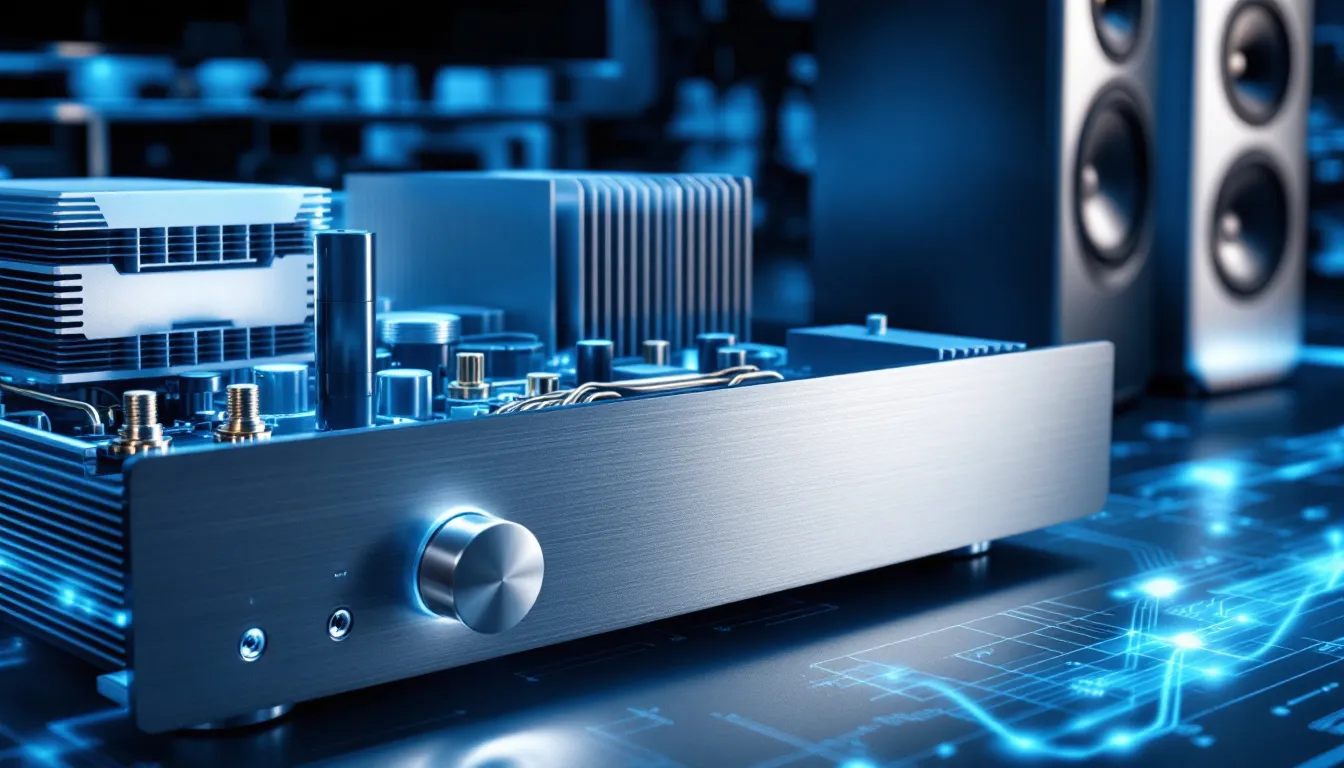
Class A amplifiers are celebrated for their superior performance in terms of audio fidelity due to their exceptional linearity and minimal distortion. These amplifiers provide exceptional sound quality because they can faithfully reproduce audio signals without introducing significant coloration. The high fidelity and accurate reproduction of sound signals make them a popular choice among audiophiles and professionals.
Understanding these advantages involves examining two primary benefits: high linearity and low distortion.
High Linearity
The output transistor in a Class A amplifier continuously conducts, leading to high fidelity in sound reproduction. This design allows for a consistent output across a wide range of frequencies, ensuring minimal variation in performance. Class A amplifiers are known for their superior linearity compared to other amplifier types. This high linearity greatly enhances audio quality, making them a preferred choice for audiophiles who seek the best sound experience.
High linearity in Class A amplifiers ensures that the input waveform is accurately reproduced at the output, resulting in a sound that is true to the original recording. This characteristic is particularly important for high-fidelity audio systems where even the slightest distortion can be noticeable. Maintaining a linear relationship between input and output signals allows Class A amplifiers to deliver a clear and immersive sound experience.
Low Distortion
The conduction of a single output transistor in Class A amplifiers provides high linearity and minimizes distortion. Low distortion levels are critical for sound quality as they ensure accurate audio reproduction. Audiophiles favor Class A amplifiers because they deliver superior sound reproduction with minimal distortion. Audiophiles choose Class A amplifiers for their home audio setups to achieve high-quality sound reproduction with minimal distortion.
By minimizing distortion, Class A amplifiers ensure that the sound produced is as close to the original recording as possible. This is particularly important for audio purists who demand the highest level of sound fidelity.
The low distortion characteristic of Class A amplifiers makes them an excellent choice for high-fidelity audio systems and professional audio equipment where sound accuracy is paramount.
Disadvantages of Class A Amplifiers

While Class A amplifiers offer numerous advantages, they are not without their drawbacks. Here are some key points to consider:
-
Low Efficiency: Class A amplifiers are known for their low efficiency, primarily resulting from the continuous operation of output transistors.
-
Power Dissipation: Due to continuous current flow, Class A amplifiers dissipate a significant amount of power as heat, which results in lower overall efficiency compared to other amplifier classes.
-
Thermal Throttling: The heat produced can lead to thermal throttling, affecting performance and potentially damaging components if not properly managed.
Examining these disadvantages involves focusing on low efficiency and higher efficiency and heat generation.
Low Efficiency
Class A amplifiers are known for their overall inefficiency, with theoretical maximum efficiencies typically around 25%. They generally have an efficiency rating that hovers around 30%, which limits their use in high-power scenarios. Power consumption in Class A amplifiers is constant regardless of output power, contributing to low efficiency due to continuous operation. Energy not used for driving speakers in Class A amplifiers is dissipated as heat, leading to excess heat generation.
The inherent inefficiency of Class A amplifiers results in significant heat production, which can affect performance and reliability. This low efficiency is a major drawback, especially in situations where power consumption and heat dissipation are critical factors.
For those who prioritize sound quality above all else, this trade-off might be worth it.
Heat Generation
Class A amplifiers generate substantial heat due to their constant power consumption, which does not decrease at idle. The continuous operation of the output transistor results in significant heat generation. The standing current in Class A amplifiers, typically required to be around half of the maximum output current, contributes significantly to heat generation.
Heat sinks and fans can effectively dissipate heat, prolonging the life of Class A amplifiers. Larger heatsinks or multiple fans can enhance heat dissipation, preventing thermal overload and ensuring consistent amplifier performance.
Forced air cooling can effectively reduce the operating temperature of Class A amplifiers, thus improving their reliability and performance. Proper thermal management is crucial for maintaining the performance and longevity of Class A amplifiers.
Applications of Class A Amplifiers
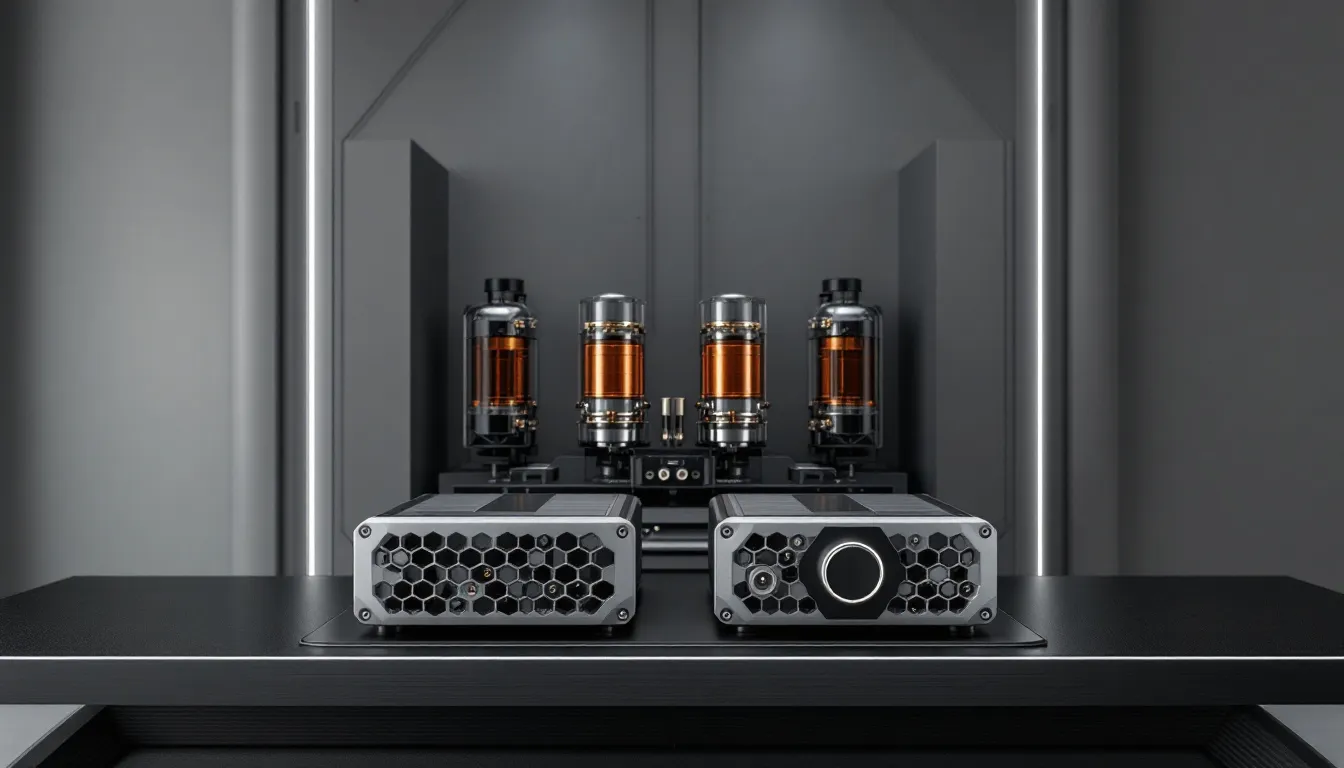
Class A amplifiers are frequently utilized in premium audio systems to ensure high sound quality. They are often used in the output stages of high-end audio devices due to their superior sound quality. These amplifiers are known for their extremely low total harmonic distortion (THD), often measured below 0.01%, which enhances overall audio clarity.
Exploring the two primary applications of Class A amplifiers involves high-fidelity audio systems and professional audio equipment.
High-Fidelity Audio Systems
Audiophiles favor Class A amplifiers for home audio setups due to their ability to deliver superior sound quality. These amplifiers are renowned for their low distortion levels, making them ideal for high-fidelity audio applications. Class A amplifiers typically exhibit minimal harmonic distortion, resulting in clearer and more natural sound output. The low total harmonic distortion (THD) of Class A amplifiers enhances overall audio clarity, providing an immersive listening experience.
In high-fidelity audio systems, the goal is to reproduce sound as accurately as possible, and Class A amplifiers excel in this regard. Their ability to deliver a pure, uncolored sound makes them the preferred choice for audiophiles who demand the best audio experience. Whether it’s for listening to music, watching movies, or gaming, Class A amplifiers provide an unparalleled sound experience.
Professional Audio Equipment
Class A amplifiers play a crucial role in professional audio environments, especially in studio monitors. They maintain audio clarity and fidelity, which is essential for accurate sound reproduction in studio monitors. Using Class A amplifiers in professional audio devices results in clearer, more accurate sound quality, enhancing the overall listening experience.
In professional settings, precise audio reproduction is crucial for tasks such as mixing and mastering. Class A amplifiers ensure that the audio signal is reproduced faithfully, allowing audio engineers to make accurate adjustments. Their superior sound quality and low distortion levels make them indispensable in professional audio equipment, where sound accuracy is paramount.
Comparing Class A with Other Amplifier Classes
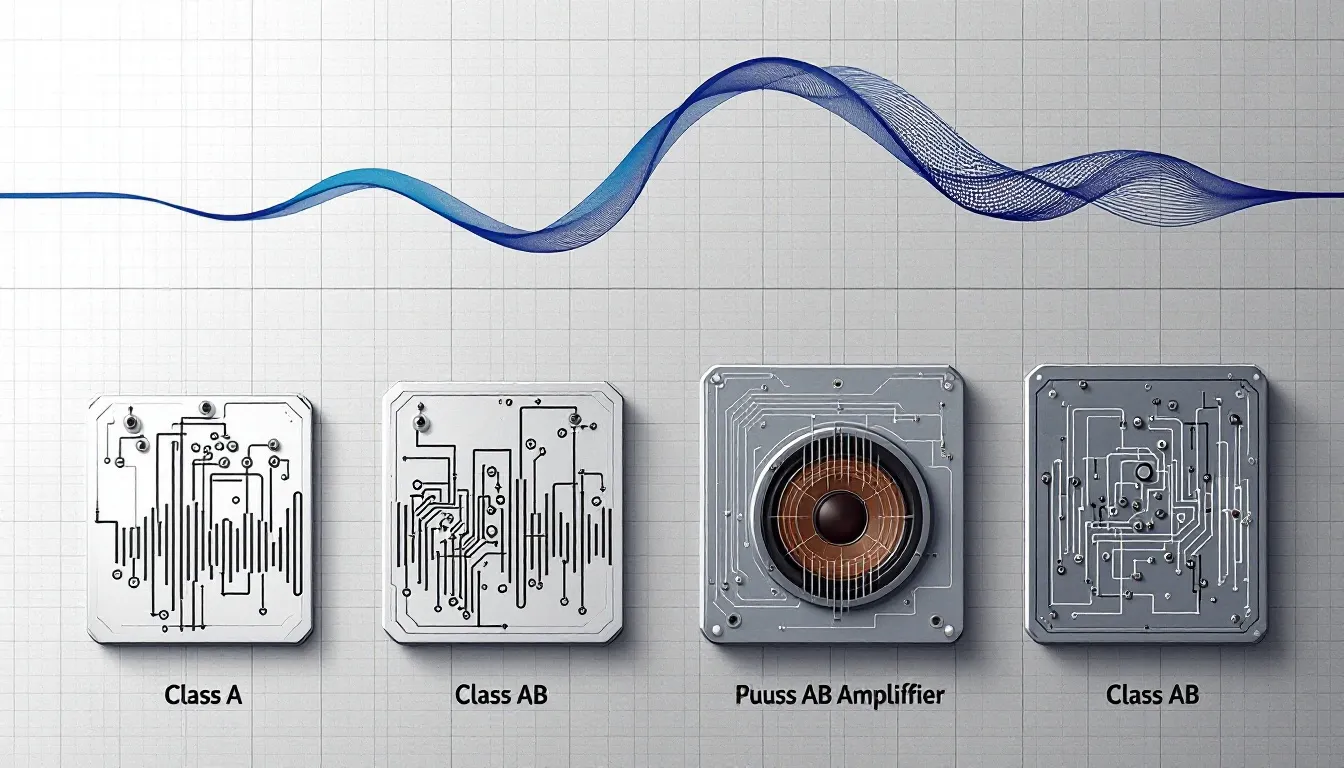
Class A amplifiers are known for their excellent linearity, high gain, and low signal distortion, making them the preferred choice for high-quality audio applications. Compared to other amplifier classes, they offer unique advantages and disadvantages in the amplifier class, particularly when considering linear amplifiers.
Comparing Class A amplifiers with Class B, Class AB, and Class D amplifiers highlights the differences from previous classes. Each comparison will highlight the strengths and weaknesses of these amplifier classes, providing a comprehensive understanding of where Class A stands.
Class A vs. Class B Amplifiers
Class B amplifiers operate with two active devices, improving efficiency by conducting only half of the input signal cycle. This means that each transistor handles one half of the waveform, which significantly increases efficiency compared to class A amplifiers. However, this efficiency comes at a cost. A class b amplifier typically suffers from crossover distortion, which occurs when the signal transitions between transistors that handle the positive and negative halves of the waveform.
In contrast, Class A amplifiers provide superior linearity and lower distortion because their single output transistor conducts throughout the entire input cycle. The continuous operation of the transistor ensures that the output signal remains smooth and free from the crossover distortion that plagues Class B amplifiers.
Although Class A amplifiers are less efficient and generate more heat, their ability to deliver high-quality, distortion-free sound makes them the preferred choice for audiophiles and professionals who prioritize sound fidelity.
Class A vs. Class AB Amplifiers
Class AB amplifiers deliver better efficiency than Class A amplifiers by combining the characteristics of both Class A and Class B designs. In a Class AB amplifier, the transistors are biased to conduct slightly more than half of the input signal cycle, reducing the crossover distortion common in Class B amplifiers while improving efficiency. This hybrid approach allows Class AB amplifiers to achieve a balance between sound quality and power efficiency, making them a popular choice for many audio applications.
While Class AB amplifiers offer enhanced efficiency compared to pure Class A designs, they still cannot match the linearity and sound fidelity of Class A amplifiers. Class A amplifiers maintain a continuous conduction state, ensuring minimal distortion and superior audio reproduction. Additionally, class a b amplifiers provide a different balance of performance characteristics.
However, the trade-off is higher power consumption and increased heat generation. For those who demand the absolute best in sound quality, Class A amplifiers remain the gold standard, despite their inefficiencies.
Class A vs. Class D Amplifiers
Class D amplifiers are known for their high efficiency, often exceeding 90%, which makes them ideal for portable and energy-conscious applications. These amplifiers use pulse width modulation (PWM) to switch the output transistors on and off rapidly, significantly reducing power loss and heat generation. This efficiency allows a class D amplifier to be used in various applications, from portable speakers to high-power sound systems, while maintaining an optimal duty cycle.
However, while Class D amplifiers excel in efficiency, they cannot match the sound fidelity of Class A amplifiers or the enhancements provided by DSP amplifiers. The switching nature of Class D amplifiers can introduce noise and distortion, which can affect sound quality.
In high-fidelity audio settings, where sound accuracy is paramount, Class A amplifiers are preferred for their ability to deliver pure, uncolored sound. Despite their higher energy consumption and heat production, Class A amplifiers remain the best class choice for audiophiles and professionals who seek the best audio experience.
Enhancing Class A Amplifier Performance
Enhancing the performance of Class A amplifiers involves optimizing key aspects such as power supply and thermal management in amplifier design. Given their inherent inefficiencies and heat generation, these amplifiers require careful attention to detail to maintain their renowned sound quality.
Focusing on these areas ensures that Class A amplifiers operate at peak performance, delivering the best possible audio experience.
Optimizing Power Supply
Optimizing the power supply is crucial for achieving the best sound quality from Class A amplifiers. Due to their inefficient nature, high output power requirements in Class A designs necessitate significant power supplies and larger heat sinks. Proper power supply selection can enhance dynamic range and reduce distortion, producing more accurate audio reproduction. Inadequate power supply configurations can reduce performance, leading to issues such as distortion and overheating.
Using regulated power supplies that can adapt to varying loads helps maintain the performance of Class A amplifiers. These power supplies ensure consistent and adequate input voltage flow, which is essential for maintaining linearity and minimizing noise, including the use of supply rails.
By investing in a high-quality power supply, users can significantly improve the performance and reliability of their power amps Class A amplifiers.
Thermal Management Solutions
Class A amplifiers are known for their low efficiency, which leads to significant heat generation during operation. The thermal management challenges for Class A amplifiers come from the excessive heat they generate, which can affect performance and lifespan. Implementing effective thermal management solutions, such as heat sinks and active cooling systems, is crucial for mitigating these issues.
Incorporating larger heatsinks or multiple fans can enhance heat dissipation, preventing thermal overload and ensuring consistent amplifier performance. Forced air cooling can effectively reduce the operating temperature, improving the reliability and performance of Class A amplifiers.
By addressing thermal management proactively, users can extend the lifespan of their amplifiers and maintain their high sound quality.
Summary
Class A amplifiers, despite their inefficiencies and heat generation, stand out for their unparalleled sound fidelity and low distortion. Their continuous conduction design ensures high linearity, making them the preferred choice for audiophiles and professionals who demand the best in audio quality. While they may not be the most efficient, the trade-offs are often worth it for those who prioritize sound over power consumption.
In conclusion, understanding the workings, advantages, and disadvantages of Class A amplifiers allows users to make informed decisions about their audio setups. Whether for home audio systems or professional applications, these amplifiers provide a level of sound quality that is hard to match. By optimizing power supply and thermal management, users can enhance the performance and longevity of their Class A amplifiers, ensuring an exceptional audio experience.
Frequently Asked Questions
Why are Class A amplifiers preferred by audiophiles?
Class A amplifiers are favored by audiophiles for their exceptional sound quality, characterized by high linearity and minimal distortion, which guarantees accurate audio reproduction.
What are the main disadvantages of Class A amplifiers?
The primary disadvantages of Class A amplifiers are their low efficiency and high heat output, necessitating effective thermal management to prevent damage.
How do Class A amplifiers compare to Class D amplifiers in terms of efficiency?
Class A amplifiers exhibit low efficiency, typically around 20-30%, whereas Class D amplifiers achieve much higher efficiency, often exceeding 90%. This significant difference makes Class D amplifiers a more energy-efficient choice.
What applications are Class A amplifiers best suited for?
Class A amplifiers excel in high-fidelity audio systems and professional audio equipment, as they prioritize sound quality and minimal distortion. This makes them ideal for applications where audio performance is critical.
How can the performance of Class A amplifiers be enhanced?
Optimizing the power supply and incorporating effective thermal management techniques, such as heat sinks and active cooling systems, can enhance the performance of Class A amplifiers. These measures ensure better efficiency and reliability in the amplifier's operation.

